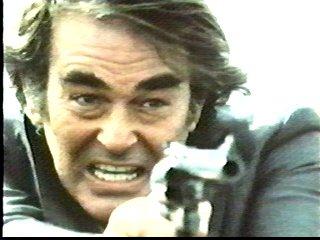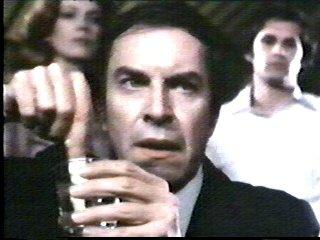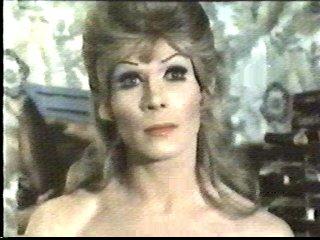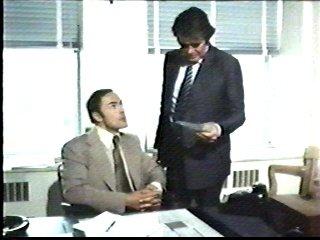
|
|
|
|
|
|
|
|
|
|
|
|
|
(a.k.a. Shadows In An Empty Room & .44 Special & Blazing Magnums & A Special Magnum For Tony Saitta & Tough Tony Saitta) (1976) Director: "Martin Herbert" (Alberto
De Martino)
Even if you don't like how police captain Tony Saitta (Whitman) works, or even if you simply don't like the guy, you have to admit one thing about him - he's one dedicated cop. There's seemingly nothing that stops him from completing any part of any investigation he is on, whether he's been actually assigned the investigation or not; even if at a particular time there are rules of procedure any ordinary cop would have to take into consideration, that won't stop Tony. Take the time when a turn in the investigation makes it necessary for him to go to an apartment to interview the three transvestites living there - he just simply barges into the place without introducing himself or explaining why he's there. Well, as you know, there's only one thing heavily lisping transvestites that call each other "fairies" will do when confronted by a threatening stranger: KUNG FU! Martial art-trained transvestites might scare off your typical cop, but not Tony. If one should throw him through a window, he'll do the same to the defenestrator minutes later. And if one should brandish a hot curling iron near his face, Tony will take it from him and give it back. (And yes, you perverts, you correctly guessed mere seconds ago just how Tony "gives back" the hot curling iron.) When Tony has them subdued, subsequently showing them his badge and asking his vital question, he's logically asked by the transvestites, "Why didn't you just tell us what you wanted?" Tony answers this by explaining, "I'm not in a social mood." Of course, it could be argued that though Tony certainly
gets the job done, he does it in a very inefficient way. Take a time
later in the movie, As you can probably tell from the previous two paragraphs, Strange Shadows In An Empty Room is not your typical mind-numbing artsy-fartsy Canadian movie - it's instead one of the few real movies the country has ever made. How was it possible such a sleazy and exploitive movie clearly aimed as a mass audience ever got made in such an environment where filmmakers in general have the ambition to bore audiences to tears? Well, in this case Canada got some help. You see, Strange Shadows In An Empty Room is actually a co-production. Canadians were involved in its making, but so were a number of Italians - and as you know, Italy back then was jam-packed with filmmakers skilled in the art of making real movies. No doubt it was the work of the Italians involved during the making of the movie that were the main reason that the finished results are an overall success. This includes their almost certain insistence that an Italian, instead of a Canadian, would take the directing chores. At first, many viewers might doubt the choice the Italians made for the director, Alberto De Martino. After all, his best-known work includes disasters like Holocaust 2000 and the Mystery Science Theater 3000 staples Operation Kid Brother and Puma Man - all real movies, yes, but not ones that any sensible person would call good. Surprisingly (and no doubt to many people's relief), De
Martino actually proved capable of this particular assignment. Clearly,
he had some idea of the particular challenges this project presented,
and made the necessary accomplishments needed to overcome them. The
most obvious challenge was that because Canadians were involved with
the movie, many customers (Canadian or otherwise)
As some readers might have guessed at this point, despite its giallo-sounding title that's in the tradition of outlandish giallo titles like What Are Those Strange Drops Of Blood Doing On Jennifer's Body?, in actual fact Strange Shadows In An Empty Room is more in the tradition of Dirty Harry than what Bava or Argento are well known for. The plot has Ottawa cop Tony pursuing a case in Montreal very personal to him - days earlier his kid sister Louise (Carole Laure), after pulling a stupid prank on university doctor George Tracer (Landau) in revenge for earlier rebuffing her for reasons unknown, suddenly dropped dead from poison in front of him and a dozen or so other witnesses. The obvious suspect is Tracer, for there's strong evidence he was having an affair with Louise, and Tony quickly starts putting the heat on him. But Tony soon learns he can't rule out the other witnesses, a motley crew that includes Louise's former boyfriend (soap opera star Jean LeClerc) who is also the son of Tracer, a female campus professor (Dallas' Gayle Hunnicutt) who is having an affair with Tracer's son, Louise's blind roommate Julie (Tisa Farrow, Mia's sister), and a friend of Louise who has a brace on his leg that makes a distinctive "clump" sound when he takes a step, a sound we instantly know will be heard in an inevitable future stalking sequence. Considering that the range of suspects includes the
handicapped, as well as everybody being connected to each other in
secretive and convoluted ways, the movie can't be seen as being totally
removed from the giallo tradition. There are other giallo
touches here and there, which include a close-up Not only is the movie strong in its action sequences, the general look of the movie, while not as strong as that of major American movies of the time, is definitely several steps up from the look found in Italian/European actioners of the time. The movie clearly had extra money at its disposal, resulting in better photography, fancier camera moves (such as some shots from helicopters), and superior-looking sets. What's also nice is the variety of good-looking locations De Martino chose in the Montreal area to shoot the movie, from the lakeside countryside to the subway system. Though not even this eye candy can save the movie from some flaws large enough that they can't be ignored - though there was really nothing De Martino could do about them. These flaws all center around the screenplay. Though many people might not be able to picture Stuart Whitman as a fascist-like cop, he doesn't do that badly... at least with what he's given, which isn't all that much. In fact, we never learn anything about his character, except that he's a hard-ass that likes to use force and is determined to see a case to its end. That's all the emotional response he ever shows; even when he is shown the corpse of his dead sister, he doesn't give out any kind of reaction, sorrow or even rage. Compare his character to Dirty Harry; while Harry certainly had a fascist side to him, upon seeing Dirty Harry again recently, one of the things that struck me was that the movie also showed a vulnerable side, ranging from trying to bottle his feelings concerning his dead wife to the various frustrations he was finding with his job. You won't find any of that multilayered character
construction here. Not just with Check for availability on Amazon (VHS) See also: Deadly Force, One Man Jury, The Violent Professionals |
 when he's looking for a notorious Montreal
fence to see if he's ever handled a key piece of jewellery that had
been discovered during the investigation. Seeing the guy from his car,
Tony sticks his head out the window and barks at the guy (without
identifying himself) that he wants to talk to him. Understandably
unnerved by this blunt and sudden confrontation, the fence flees on
foot, resulting in a very long foot chase through the streets and into
the subway system, with Tony finally cornering the guy in the men's
room. Kicking the stall door in (which seriously bashes the fence in
the face in the process), Tony drags the guy to the sinks and
repeatedly holds the guy's head underwater during his makeshift
interrogation so he'll 'fess up... until realizing the pleading
half-drowned guy really doesn't know a thing. Oops. In fairness, this
lack of procedure sometimes is seen in others as well. In one part of
the investigation, Tony finds a locker key. When he locates the locker
and prepares to open it, he is suddenly jumped by two strangers,
resulting in a long struggle that has Tony defending himself with his
fists and repeatedly slamming the guys against the lockers. Overcoming
them, Tony pulls out his badge and prepares to arrest them - but it
turns out they were locker security, only now pulling out their IDs and
explaining that they suspected he was a thief. Oops.
when he's looking for a notorious Montreal
fence to see if he's ever handled a key piece of jewellery that had
been discovered during the investigation. Seeing the guy from his car,
Tony sticks his head out the window and barks at the guy (without
identifying himself) that he wants to talk to him. Understandably
unnerved by this blunt and sudden confrontation, the fence flees on
foot, resulting in a very long foot chase through the streets and into
the subway system, with Tony finally cornering the guy in the men's
room. Kicking the stall door in (which seriously bashes the fence in
the face in the process), Tony drags the guy to the sinks and
repeatedly holds the guy's head underwater during his makeshift
interrogation so he'll 'fess up... until realizing the pleading
half-drowned guy really doesn't know a thing. Oops. In fairness, this
lack of procedure sometimes is seen in others as well. In one part of
the investigation, Tony finds a locker key. When he locates the locker
and prepares to open it, he is suddenly jumped by two strangers,
resulting in a long struggle that has Tony defending himself with his
fists and repeatedly slamming the guys against the lockers. Overcoming
them, Tony pulls out his badge and prepares to arrest them - but it
turns out they were locker security, only now pulling out their IDs and
explaining that they suspected he was a thief. Oops. might
immediately retreat from the theaters once they knew Canadians were
involved, especially since this is one of the rare Canadian movies to
actually make clear it's taking place in Canada. So before the first
five minutes of the movie have completely played out, De Martino shows
a pedestrian almost getting run over by a speeding car, a head shoved
through a glass pane, someone getting pushed over a railing and landing
heavily on a marble floor, machine-gun bullets hitting cops in the
face, cop cars tumbling around multiple times and cracking up, a car
chase, a car ramming into a building, and Tony gunning down several
people with his trusty Magnum. Clearly, all this material immediately
erases any doubt that might have built in any member of the audience.
It could be argued that this material comes across as extremely
gratuitous, since nothing in this colorful (and strangely compelling)
display has the slightest influence to anything that subsequently
happens in Strange Shadows In An Empty Room, but
sacrifices sometimes must be made in the art of filmmaking.
might
immediately retreat from the theaters once they knew Canadians were
involved, especially since this is one of the rare Canadian movies to
actually make clear it's taking place in Canada. So before the first
five minutes of the movie have completely played out, De Martino shows
a pedestrian almost getting run over by a speeding car, a head shoved
through a glass pane, someone getting pushed over a railing and landing
heavily on a marble floor, machine-gun bullets hitting cops in the
face, cop cars tumbling around multiple times and cracking up, a car
chase, a car ramming into a building, and Tony gunning down several
people with his trusty Magnum. Clearly, all this material immediately
erases any doubt that might have built in any member of the audience.
It could be argued that this material comes across as extremely
gratuitous, since nothing in this colorful (and strangely compelling)
display has the slightest influence to anything that subsequently
happens in Strange Shadows In An Empty Room, but
sacrifices sometimes must be made in the art of filmmaking. shot of a
black-gloved hand holding a shiny switchblade, a character discovering
that they are not quite alone after all in their home (hearing but
never seeing the mysterious intruder), and someone finding themselves
helpless when a loved one is getting slaughtered right in front of
them. These touches are part of what contributes to the success of
Strange Shadows In An Empty Room, making it unlike the typical
Dirty Harry rip-offs (Italian or otherwise) of
the time. These stylish touches not help break the movie from
more or less having a plot and feel for what's typical for the formula,
they are actually pretty well done by themselves, showing some style
and giving the movie a little suspense at the same time. Though as I
previously mentioned, most of the focus on the movie is on action, and
that is pretty well done as well. Oh sure, the action by and large
comes across as completely gratuitous, forced into the movie with the
flimsiest of excuses and not having the least bit of consequence to the
story. But all the same, these are entertaining action
sequences, with De Martino delivering the action in a hard-hitting
style as well as with some goofy touches. (Come on - kung fu
transvestites?) The highlight action sequence is a car chase, one that
went on for so incredibly long, with the cars creating so much
destruction when not performing simply unbelievable stunts, that I was
laughing out loud even before it was half over. Totally ludicrous, but
I will admit it's one of the most entertaining car chases I've ever
seen.
shot of a
black-gloved hand holding a shiny switchblade, a character discovering
that they are not quite alone after all in their home (hearing but
never seeing the mysterious intruder), and someone finding themselves
helpless when a loved one is getting slaughtered right in front of
them. These touches are part of what contributes to the success of
Strange Shadows In An Empty Room, making it unlike the typical
Dirty Harry rip-offs (Italian or otherwise) of
the time. These stylish touches not help break the movie from
more or less having a plot and feel for what's typical for the formula,
they are actually pretty well done by themselves, showing some style
and giving the movie a little suspense at the same time. Though as I
previously mentioned, most of the focus on the movie is on action, and
that is pretty well done as well. Oh sure, the action by and large
comes across as completely gratuitous, forced into the movie with the
flimsiest of excuses and not having the least bit of consequence to the
story. But all the same, these are entertaining action
sequences, with De Martino delivering the action in a hard-hitting
style as well as with some goofy touches. (Come on - kung fu
transvestites?) The highlight action sequence is a car chase, one that
went on for so incredibly long, with the cars creating so much
destruction when not performing simply unbelievable stunts, that I was
laughing out loud even before it was half over. Totally ludicrous, but
I will admit it's one of the most entertaining car chases I've ever
seen. Tony, but from any of
the supporting players. Playing the prime suspect of the investigation,
Landau (who looks utterly bewildered to be in this kind of movie) ends
up repeatedly protesting his innocence throughout the movie and not
much more than that. It's even worse for John Saxon, whose role proves
to be utterly useless. He plays the Montreal chief of police who
assists Tony in his investigation... though I don't think what he does
can ever really be called "assistance". All he ends up being is a
chauffeur to Tony, as well as to be near Tony at key moments so that
Tony can say out loud (for the benefit of the audience) what he's
discovered and what he'll next be doing in his investigation. Speaking
of the investigation itself, when you look at the mystery itself you
can't really call it a mystery. Those even remotely familiar with
mystery movies will be able to spot obvious red herrings early on, so
that when the culprit is finally revealed it's not much of a surprise.
And there aren't actually that many important plot points discovered
between the murder and the revelation of the culprit - the time between
each important discovery is severely padded out with events that go
nowhere (such as the sink dunking) or dollops of gratuitous action. The
heart of this movie is a dumb action flick, but you know, I think all
of us have at times a soft spot for dumb action, at least if the action
is as well executed as it is here. So when you know when you're in one
of those moods, you'll be surprised as to how much you won't notice the
dumb parts of Strange Shadows In An Empty Room.
Tony, but from any of
the supporting players. Playing the prime suspect of the investigation,
Landau (who looks utterly bewildered to be in this kind of movie) ends
up repeatedly protesting his innocence throughout the movie and not
much more than that. It's even worse for John Saxon, whose role proves
to be utterly useless. He plays the Montreal chief of police who
assists Tony in his investigation... though I don't think what he does
can ever really be called "assistance". All he ends up being is a
chauffeur to Tony, as well as to be near Tony at key moments so that
Tony can say out loud (for the benefit of the audience) what he's
discovered and what he'll next be doing in his investigation. Speaking
of the investigation itself, when you look at the mystery itself you
can't really call it a mystery. Those even remotely familiar with
mystery movies will be able to spot obvious red herrings early on, so
that when the culprit is finally revealed it's not much of a surprise.
And there aren't actually that many important plot points discovered
between the murder and the revelation of the culprit - the time between
each important discovery is severely padded out with events that go
nowhere (such as the sink dunking) or dollops of gratuitous action. The
heart of this movie is a dumb action flick, but you know, I think all
of us have at times a soft spot for dumb action, at least if the action
is as well executed as it is here. So when you know when you're in one
of those moods, you'll be surprised as to how much you won't notice the
dumb parts of Strange Shadows In An Empty Room.